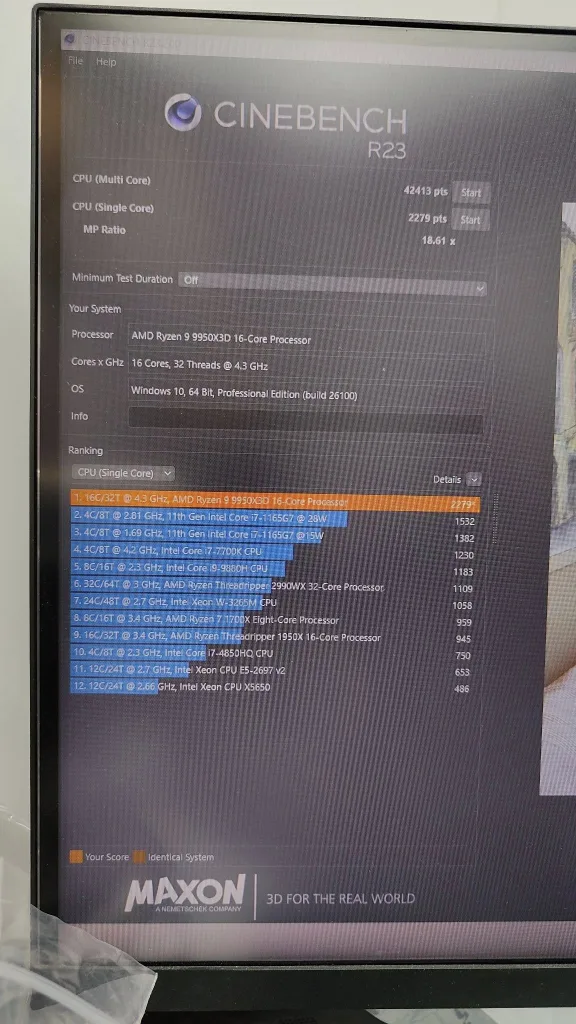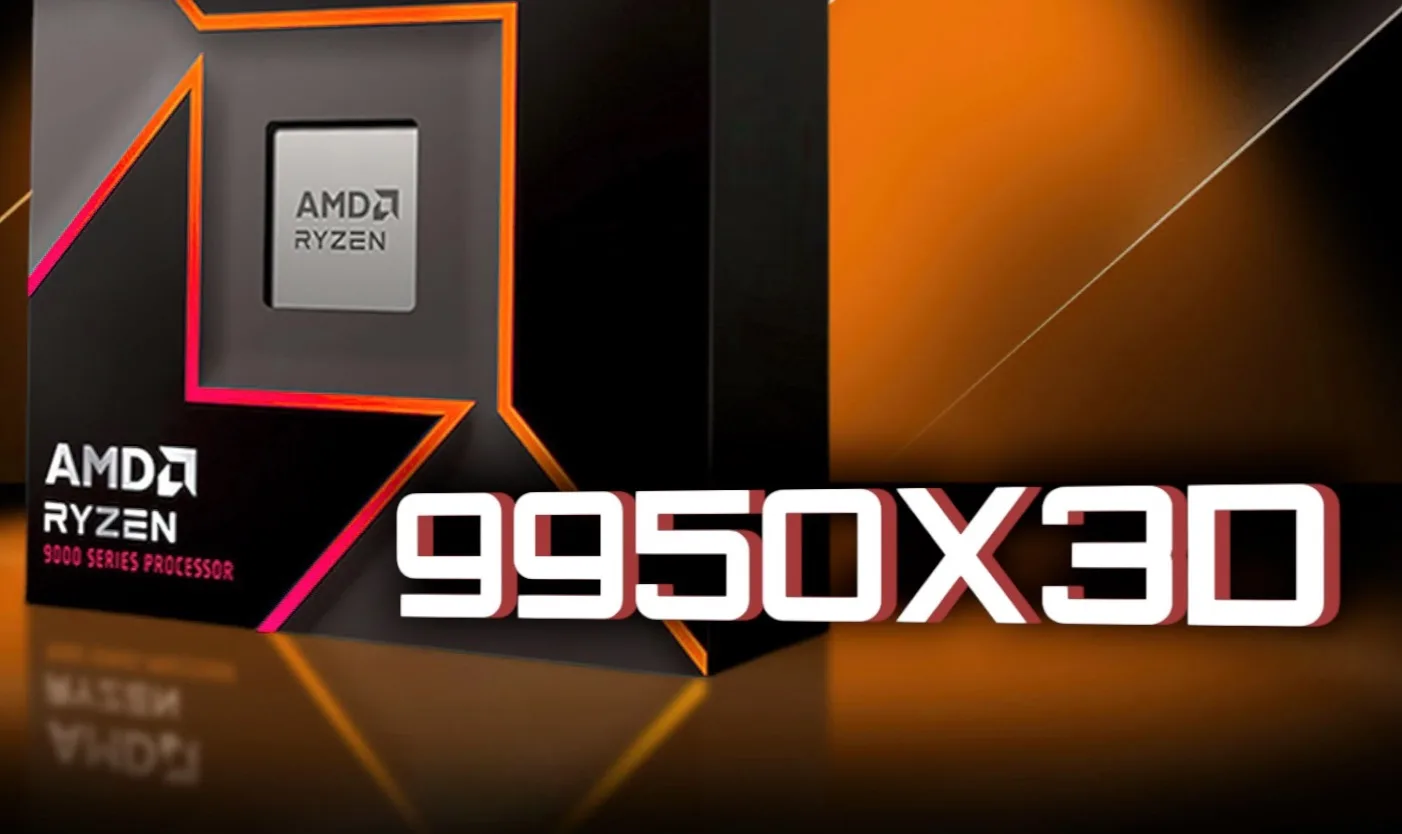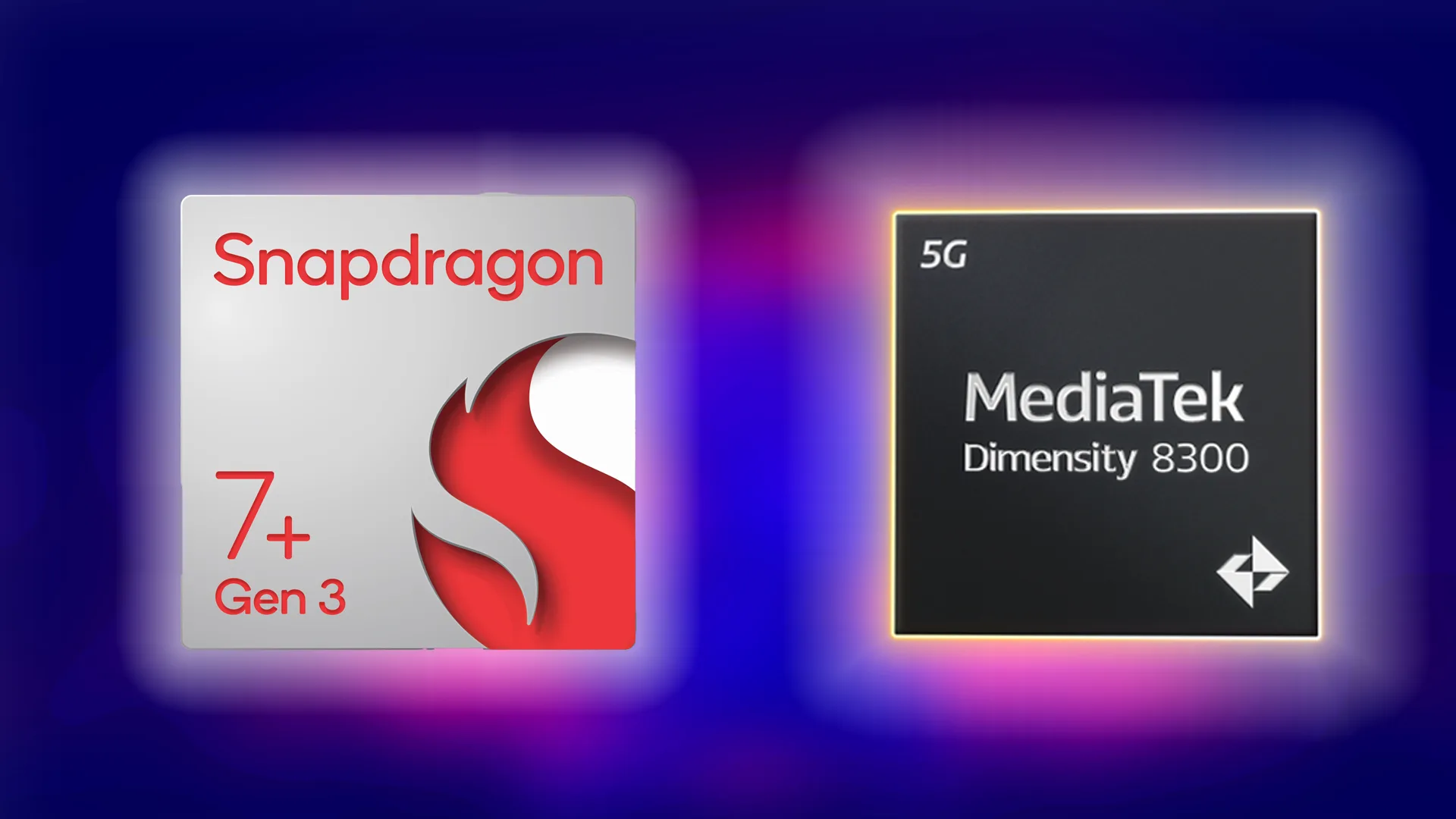The much-anticipated AMD Ryzen 9 9950X3D is making waves ahead of its official release, with leaked benchmarks suggesting performance on par with its non-X3D sibling, the Ryzen 9 9950X. Thanks to an early look from PC Build, we now have an idea of what this processor brings to the table—and it’s impressive.
Table of Contents
Ryzen 9 9950X3D Shines in Cinebench R23 and 3DMark Tests
According to the leaked results, the Ryzen 9 9950X3D scored 42,413 points in the multi-core Cinebench R23 test, slightly edging out the Ryzen 9 9950X’s 41,808 points. The single-core performance also remains virtually identical, with the 9950X3D delivering 2,279 points, matching its non-X3D counterpart.
In 3DMark’s CPU Profile Max Threads test, the Ryzen 9 9950X3D achieved 17,234 points, putting it in the same performance bracket as the 9950X. This suggests that the additional L3 cache doesn’t significantly impact synthetic benchmark scores but could prove advantageous in real-world applications, particularly gaming.
Understanding Synthetic Benchmarks vs. Real-World Performance
Synthetic benchmarks provide a controlled environment to measure CPU performance, but real-world applications such as gaming, video editing, and software development tell a different story. The added L3 cache in the 9950X3D could significantly impact workloads that rely heavily on cache memory, especially in games where data retrieval speed affects frame rates.
In practical applications, CPUs with larger cache sizes tend to reduce memory latency and improve performance in cache-sensitive scenarios. This means that while the Ryzen 9 9950X3D performs similarly to the 9950X in synthetic tests, users may notice a tangible improvement in gaming responsiveness and professional workflows.

What Makes the Ryzen 9 9950X3D Stand Out?
While the clock speeds of the 9950X3D and 9950X are nearly identical, the X3D version differentiates itself with a massive 64MB of extra L3 cache, strategically placed on a 3D chiplet. This means:
- Better gaming performance in cache-sensitive titles.
- Enhanced efficiency in certain productivity tasks.
- No major trade-offs in clock speeds, unlike previous X3D models.
The processor features dual CCDs, each with 8 cores and 32MB of L3 cache, while one CCD gets an additional 64MB of stacked cache. The boost clock reaches 5.7 GHz on the non-X3D CCD, while the X3D CCD maxes out at 5.54 GHz, similar to the 9950X.
A Look at Gaming Performance and Use Cases
One of the most anticipated aspects of the Ryzen 9 9950X3D is its gaming performance. With the previous generation’s Ryzen 7 7800X3D outperforming even the high-end Ryzen 9 7950X in gaming benchmarks, expectations are high for the 9950X3D.
How the 3D V-Cache Impacts Gaming
The 3D V-Cache technology in AMD’s X3D lineup offers a crucial advantage in gaming. Games often rely on high-speed access to frequently used data, and a larger L3 cache reduces the need to fetch data from slower system memory. This translates to:
- Higher minimum frame rates for a smoother experience.
- Lower latency in CPU-bound games such as eSports titles.
- More consistent performance across various gaming scenarios.
For gamers who play AAA titles or competitive shooters, the Ryzen 9 9950X3D could deliver a noticeable boost in smoothness and frame pacing compared to traditional high-core-count CPUs.
The First-Ever 170W TDP X3D Chip
One of the biggest surprises is the 170W TDP, a significant jump from the 120W limit of past X3D processors. This increase could suggest better cooling and power headroom, making it an appealing choice for power users.
Historically, AMD’s X3D chips have been designed with a power efficiency focus, often sacrificing clock speeds to maintain thermal performance. However, the Ryzen 9 9950X3D breaks this mold with a higher power ceiling, potentially allowing for better sustained performance under heavy workloads.
This also raises questions about cooling solutions. Users upgrading from previous X3D models may need to invest in high-end air or liquid cooling to take full advantage of the 9950X3D’s potential.

Comparison with Intel’s Offerings
With Intel’s 14th-gen Raptor Lake refresh and upcoming Arrow Lake processors on the horizon, the competition in the high-performance CPU market is fierce. AMD’s 3D V-Cache technology gives the Ryzen 9 9950X3D a clear advantage in gaming, but Intel’s chips still hold their ground in raw multi-threaded performance.
Intel’s Core i9-14900K features higher out-of-the-box clock speeds and better single-threaded performance in applications that prioritize frequency over cache size. However, in real-world gaming benchmarks, AMD’s X3D chips have consistently outperformed Intel’s flagship CPUs.
For content creators and professionals, the decision between AMD and Intel depends on workload priorities. Those needing fast rendering, AI-driven workloads, and heavy multi-threading might still lean toward Intel, while gamers and general users will likely see more benefits with AMD’s 3D V-Cache design.
Expected Launch Date and Pricing
The Ryzen 9 9950X3D is rumored to launch on March 12, though AMD has yet to confirm official details. Early listings suggest a price of $699, while its smaller counterpart, the Ryzen 9 9900X3D, is expected to debut at $599. With a 12-core/24-thread configuration, the 9900X3D could be an ideal pick for gamers and content creators looking for high performance without the premium cost of the 9950X3D.
Should You Upgrade?
Who Should Buy the Ryzen 9 9950X3D?
- Enthusiast gamers who want the best possible frame rates in CPU-bound titles.
- Streamers and content creators needing strong multi-threaded performance.
- Users upgrading from older Ryzen chips who want next-gen performance and efficiency.
Who Might Skip the Upgrade?
- Professionals needing the absolute best multi-threaded performance may find better options in workstation-class CPUs.
- Budget-conscious gamers may prefer the Ryzen 9 9900X3D or previous-gen Ryzen 7 7800X3D, which still deliver excellent gaming performance at a lower cost.
Final Thoughts: A Game-Changer for Gamers and Power Users
If you’re a gamer or a professional looking to maximize performance, the Ryzen 9 9950X3D could be a game-changer. While it may not offer a dramatic uplift in synthetic tests over the 9950X, the added L3 cache could make a real difference in gaming and select workloads.
With its high-end specs, enhanced cache, and increased power budget, AMD’s latest X3D chip is shaping up to be one of the most exciting CPU releases of 2025. Stay tuned for official reviews and real-world performance benchmarks!







